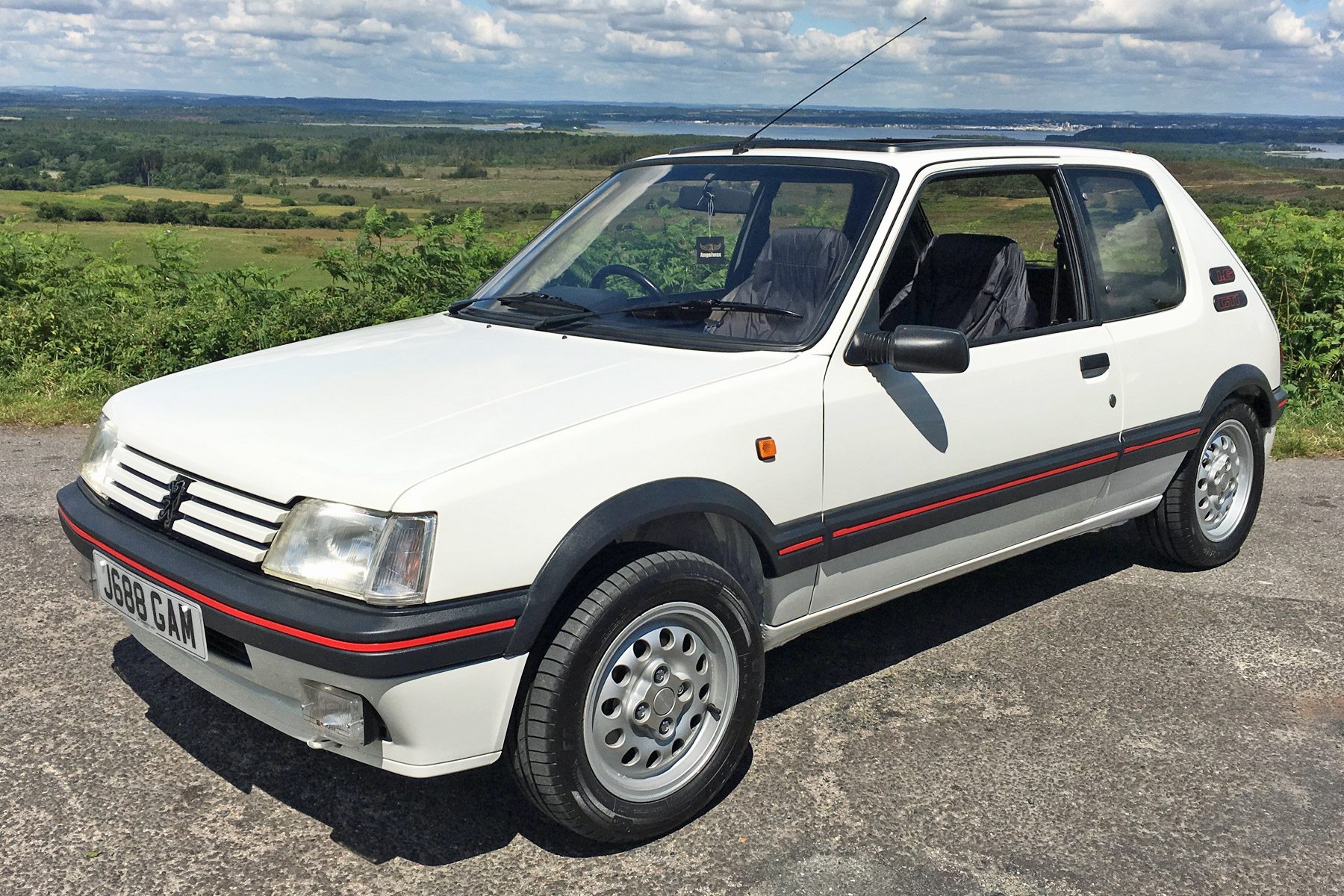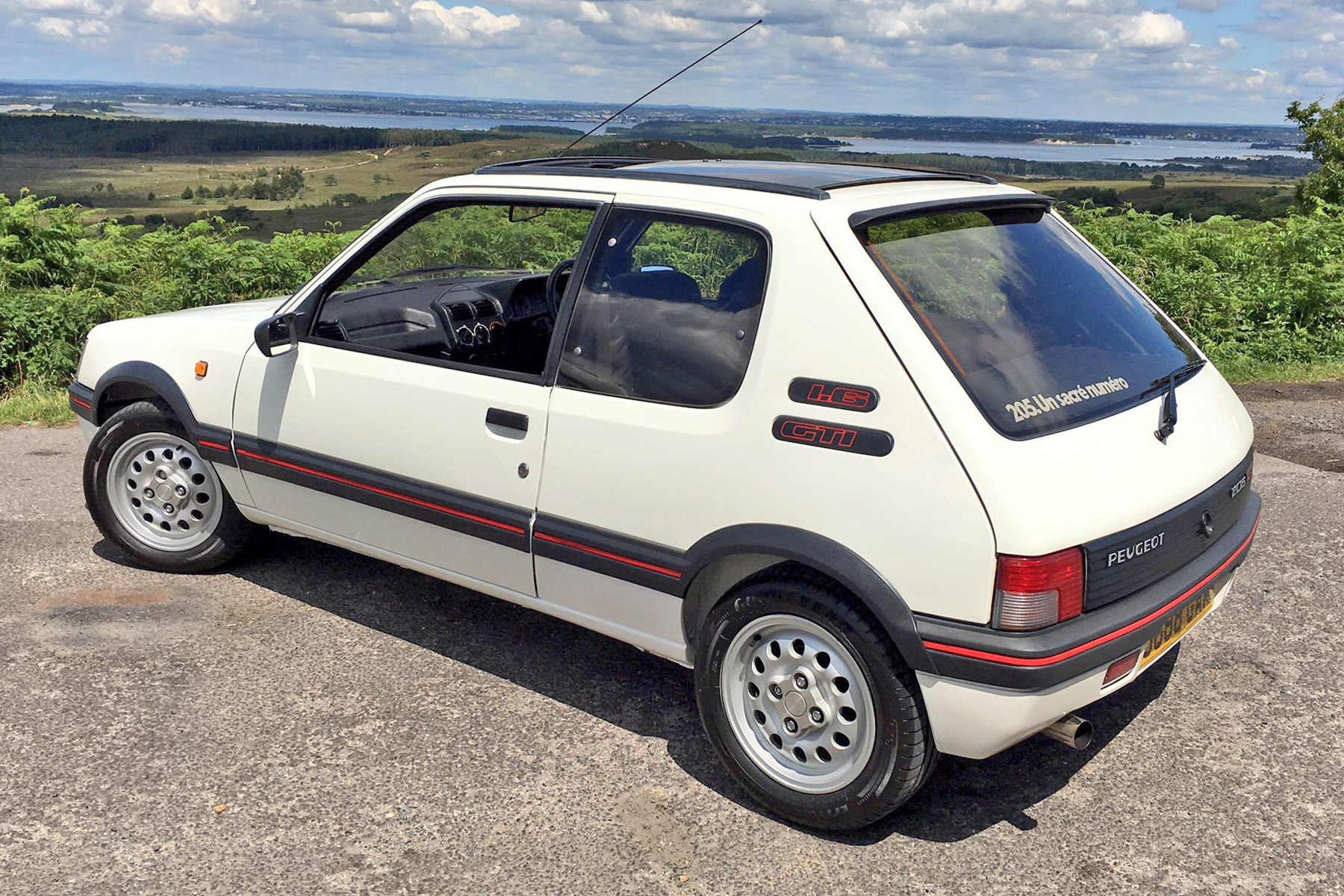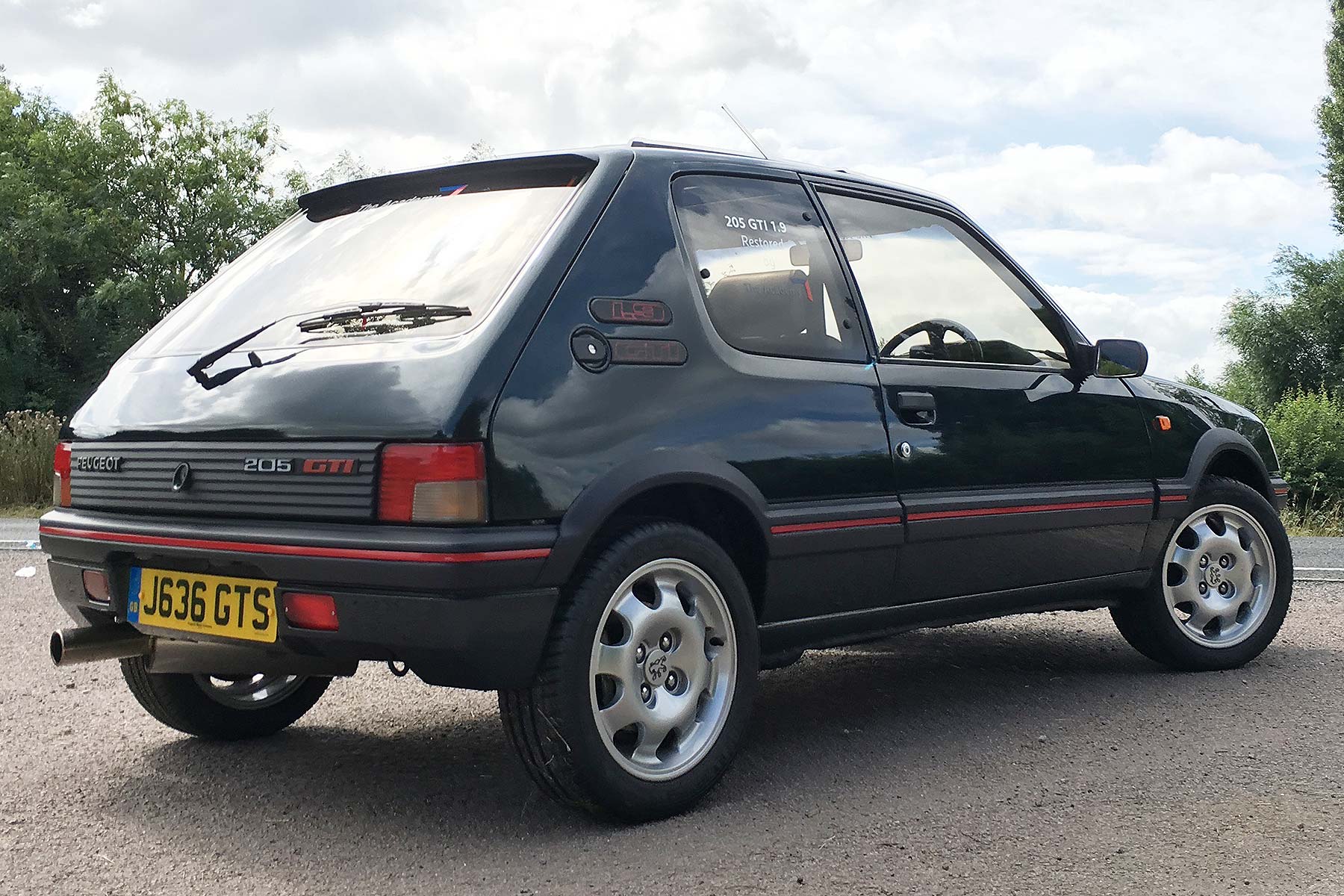Welcome to a Retro Road Test special: a face-off between two very different examples of a great (arguably the greatest?) hot hatchback. What else but the Peugeot 205 GTI?
When the 205 GTI was launched in 1984, it wasn’t the first go-faster hatch on the block. It followed in the tyre tracks of the equally legendary Volkswagen Golf GTI, while further competition came from the Renault 5 GT Turbo, Fiat Uno Turbo and Ford Fiesta XR2.
The first car we’ve driven is an original 205 GTI 1.6 in concours condition. While a more powerful 1.9-litre version followed, many purists rate the revvier 1.6 as the ultimate 205.
The apprentices from the Peugeot Performance Academy, who created the second (black) car here, felt differently. They were given a training project to die for: restore a grotty 205 GTI to perfect condition. Along the way, however, they swapped the standard engine for something a bit more special…
Building a hotter hatch

Early examples of the 205 GTI mustered a modest 105hp, a figure beaten by many standard superminis today. Yet they also weighed less than 900kg. Peugeot upped output to 115hp a few years later, then the really exciting upgrade came in 1987: the launch of the 205 GTI 1.9.
This enlarged engine offered a thrilling 130hp for 0-60mph in 7.8 seconds (the 1.6 needed 8.7 seconds). It had lots more torque as well – 119lb ft rather than 98lb ft – so felt notably more muscular. Thankfully, Peugeot fitted rear disc brakes and bigger 15-inch alloy wheels.
However, save for the addition of a catalytic converter in the early 1990s, that was it for 205 GTI evolution. It wouldn’t happen today: Peugeot would surely create a swansong special edition – fitting the 16-valve version of the 205’s ‘XU’ engine, for example.
Yes, this unit was freely available in the range, sported by the larger Peugeot 405 Mi16 and Citroen BX GTI 16v. Boasting 160hp, the all-aluminium 1.9-litre engine had a motorsport-spec head, revved to 7,200rpm and, even in the 1,100kg 405, was good for 0-60mph in 7.8 seconds. In the 205, it could have been heroic.
And for years, that’s just what the tuning scene has done: creating the 205 GTI 16v, the hot hatch that never was. It’s an easy engine swap if you know what you’re doing, or so a Peugeot veteran told us, adding weight to the logic of what could have been.
When tuners tell you it will do sub-6.5 seconds to 60mph easily, you can only conclude Peugeot might have dropped the ball by not making it…
Peugeot 205 1.6 GTI: Original and best?

While values of all 205 GTIs have soared (the best examples sell for £40,000+ at auction), the lesser 1.6 is still more affordable. That’s despite enthusiasts reporting this is the one to have.
To find out what the fuss around a standard 205 is all about, we borrowed a show-winning example from motoring writer and well-known GTI enthusiast Chris Hughes.
Built in 1991, this 205 GTI has been owned by Chris since 2000. It’s not led a sheltered life, having tackled numerous European road trips, but it’s been meticulously cared for, and has won prizes at classic car shows.
We spent a day with a car on rural Dorset roads, and what a car for a B-road blast! It’s such a pure, mechanical experience – the heavy clutch takes a minute or two to get used to, while the unassisted steering requires muscle around town.
Once you get into the 205 GTI’s groove, though, it’s an absolute joy. Working towards 6,000rpm (“I rarely go over 5,000rpm,” Chris nudges me), with the car’s Milltek exhaust (its only modification) providing a rorty soundtrack, it makes many modern hot hatchbacks feel a bit sterile.
And the best thing? It’s all happening at sensible speeds. Take a roundabout a similar pace to your average Toyota Prius driver and you’ll be having infinite fun, while even ragging it down dual carriageways won’t get you into licence-losing territory.
Peugeot 205 Mi16: Modified magic

Can you improve on a French icon? The Peugeot Performance Academy apprentices certainly thought so: It’s as tacit an ‘OE approved’ admission as could be. Using the same engine mounts as the regular 1.9 motor, all that’s needed is a bit of tweaking to clear the inlet and exhaust manifolds.
Peugeot’s car has a 205 Automatic bonnet, to provide extra clearance over the engine, but it’s not really necessary. And once installed, the 16-valve engine looks factory-spec.
It doesn’t feel modified either. It rumbles, vibrates and hums at tickover like a regular retro car, has the same impossibly direct, rifle-bolt gearshift as all 205 GTIs, has similarly heavy non-PAS steering until you’re moving and pulls at lower speeds with the same free-breathing vim as all non-emissions-conscious cars of the 1980s.
Heavens, though, it’s fast. It still weighs barely 900kg, so pick-up is instant and effortless, but the way it powers forward as the revs rise is staggering. It gets on cam and comes alive above 4,500rpm – the kick is Honda VTEC-like – and, with a heavenly induction roar and cam yowl, it explodes towards the redline. A few seamless gearchanges later and you’re quickly backing off to regain legality.
This is no shabby conversion that feels ready to fall apart. It’s the mighty 205 to sucker every other GTI on the planet, an engaging speed demon that even today feels sensational. Particularly as all the effervescence of the 205 GTI chassis remains intact. The wider 1.9 GTI wheels mean more planted handling, stacks of front grip and a more trustworthy rear end. Yet there’s still the blindingly well-telegraphed on- and over-the-limit exploitability that so many love.
The firm, ever-varying weight of the steering is to die for, body control is exemplary and the free-flowing connectivity to the road surface is Lotus-esque. Because it’s so light, it doesn’t need to be over-stiff – the suspension is softer than you may expect, meaning the ride is better than you’d ever believe – which enhances its fast-road ground-covering ability. With a revvy 160hp to play with, it’s incendiary.
Lion kings: Choosing a winner

Andrew Brady’s winner…
Both of these cars would be lovely things to keep in your garage, ready to enjoy on sunny days while also increasing in value with every bit of TLC you give them. The Mi16 is a tantalising glimpse of what might have been: the world’s finest hot hatch could have been a true performance icon with that wonderful Mi16 engine.
However, as a car to truly enjoy, the light and nimble 1.6-litre 205 GTI is hard to beat. Peugeot got it spot-on, and this version offers maximum thrills for the least outlay. Buy one while you still can.
Richard Aucock’s winner…
I was amazed. In my youth, a 205 Mi16 was an ultimate, right up there with a red-top Vauxhall Nova for teenage desirability. But with age came the love of originality – what could modders know that the car manufacturer didn’t? In this case, plenty, because the 205 GTI Mi16 – the 205 GTI 16v – is sublime. It’s the greatest GTI that never was.
It takes all that’s wonderful about the regular car and builds upon it with a searing, exotic, race-bred engine that, because the car itself is so light and pure, you interact with so tremendously vividly. It feels factory-original, it drives brilliantly and it’s simply thrilling to experience. I surprised myself with how much I loved this car. Find one done right and so will you.
ALSO READ:
Peugeot 205 GTI Tolman Edition 2021 review



[…] Honda Civic Type R will be rated among the greats. Remember how Chris Harris compared it to a Peugeot 205 GTI on Top Gear? Yes, it’s that […]